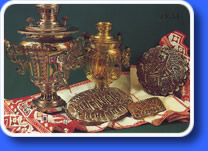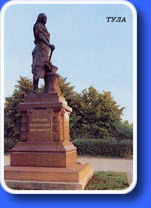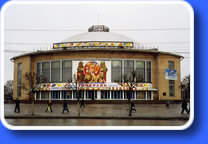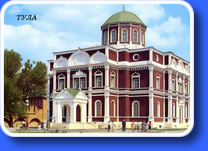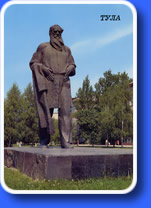
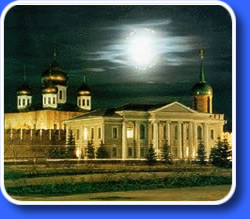
Tula -
city and administrative centre of Tula oblast (province), western Russia. It lies along the Upa
River, which is a tributary of the Oka River.
First mentioned in 1146 as Taydula, Tula became
the principal stronghold on the southern approaches to Moscow in the 16th century and the center of a series of defensive lines against Tatar attack. A stone citadel of 1530, restored in 1784 and 1824, survives.
In 1552 the city successfully resisted a siege by the Tatars. During the 17th century, Tula developed into the major ironworking city of Russia. It was the site of Russia's first armament factory, built in 1712 by Peter I the Great, and remains a large armament producer.
Besides iron and steel, modern Tula has a range of engineering industries. Much
lignite (brown coal) is mined locally and used in the chemical industry. Samovars are a
traditional manufacture.
The city has mechanical, mining, and teacher-training institutes
and one devoted to coal-mining research. Tula was the first place in Russia to develop a ferrous
metallurgy and metalprocessing industry. In metal processing Tula craftsmen acquired great
skill. But most of the enterprises were handicraft artels and small plants producing samovars
and different handmade goods.
With the development of capitalism in Russia industrial enterprises in Tula increased in number. By the end of the 19th century Tula had about 200 enterprises with 13 thousands of workers.
During the years of Soviet power handicraft workshops have been transformed into modern well
equipped enterprises. At present here are many plants and factories in Tula. The Novotulsky Iron
and Steel Works was the first to master the continuous steel casting. This plant produces iron
and steel of various grades. The old gun-making plant produces hunting rifles and sport guns
which help our Soviet sportsmen to win victories at international competitions. The machine
building plants produce metal cutting machines, radio appliances, motor scooters, washing
machines, powerful pumps. There is also a plant in Tula, which manufactures farm machinery.
As in the old days Tula is famous of its samovars, and its accordions which more than once
have won prizes at international trade fairs. In the Tula region there are many coal-mining
enterprises and large chemical works.
Today's Tula is not only an industrial but also a cultural and educational center
of our country. The population of Tula is about half a million. Tula has some research institutions
and many educational establishments. Three theatres, a circus, a regional philharmonic society,
many clubs and palaces of culture, numerous libraries and reading rooms, illustrate the rising
cultural level of the population.
Tula has many places of interest. The Museum of Arms is well known not only in our town. It was established in 1724. In the museum we can see the products of skillful Tula gunsmiths. It has models of Russian weapons beginning with the Kulikovo Battle in 1380 to the years of the Great Patriotic War.
There are also tiny engravings, which one can see
only through a microscope. The Museum of Regional Studies is of great interest too. It presents
to its visitors the heroic past of our town. The Art Gallery has a collection of rare pictures,
sculptures and items of applied arts.
Not far from Tula is Yasnaya Polyana. Here the great Russian writer Leo Tolstoy lived and worked for almost all his life. Now it is a Museum. Many people not only from our country but also abroad visit Yasnaya Polyana every day.
The Kremlin, the Victory Square with its eternal flame and the monument to the
defenders of Tula, the vast central Town Park belong to the sights of Tula. The picture will
not be complete if we forget our central stadium with its sports playgrounds, the indoor
stadium and the famous cycledrome.
The appearance of our town has greatly changed. From a dirty provincial town with wooden houses and narrow streets before the revolution it has turned into a modern city. The main street of our town and many other tree-lined streets are always full of people and the traffic is rather busy. In the streets we can see many cars, buses, trolleybuses, trams, taxis. Tula grows from day to day. Old houses and back yards have almost completely disappeared giving way to new high buildings. New modern-style districts have appeared in the former suburbs of Tula.
The citizens of Tula are proud of their town which becoming more beautiful from
day to day!
|
||||
© 2000-2013, Ruslan Esaulov







